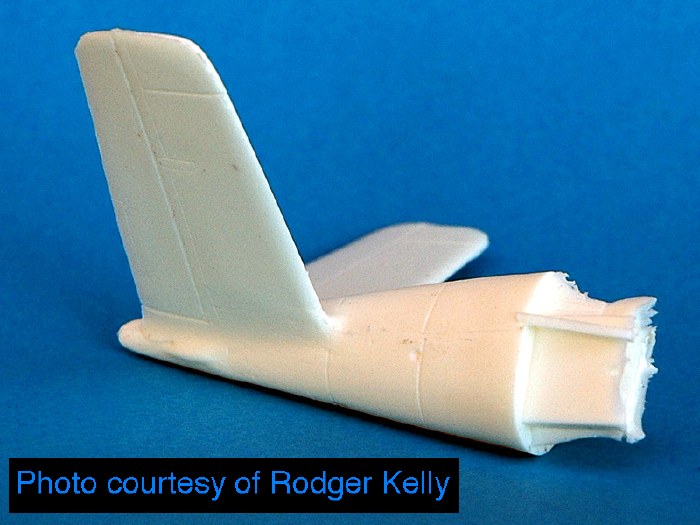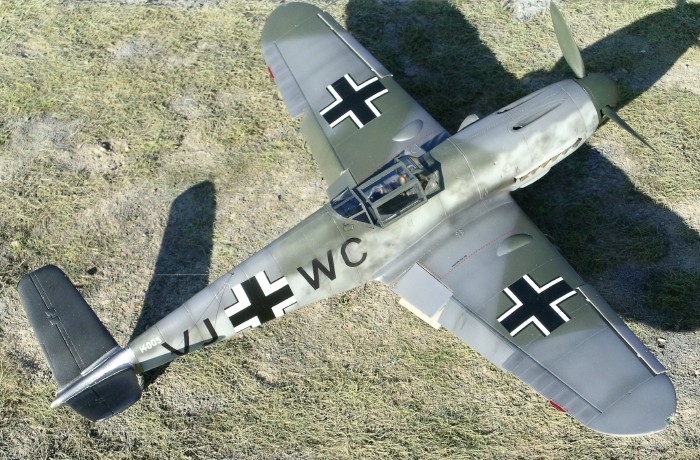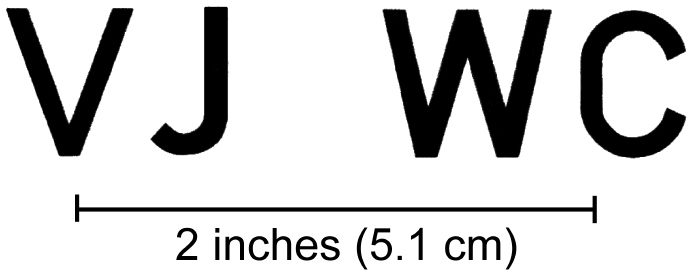|
Pro Modeler + UMI + Aires 1/32 scale
Bf109G-0 V-tail Prototype
by
Ian Robertson
|
 |
|
Messerschmitt Bf109G-0
V-tail Prototype |

ProModeler's
1/32 scale Messerschmitt Bf 109G-4
is available online from Squadron.com
If you are a fan of the Messerschmitt Bf.109, and
if you are looking for something a little different to build, UMI
(Unlimited Models Inc) offers a conversion for an esoteric subject – the
experimental Bf109G-0 V-tail prototype (WkNr 14003). Only the one
prototype was produced, and the V-tail design never went into production
because it offered no real improvement in performance over the standard
tail design. Information on the V-tail Bf.109 is difficult to come by,
but here I piece together what I could find or deduce.
As far as I can tell only three photos of the
V-tail Bf.109 exist (search “Bf.109 v48” at
http://www.alltheweb.com/
for the three images). Two of
the three photos are tail shots, and the third is a photo from behind
that reveals important details about the wings, propeller, and canopy.

While the photos were helpful in planning my
project, questions arose regarding general details of the Bf109G-0
variant. These problems were cleared up when I happened onto some
information in Prien and Rodeike’s “Bf109 F,G & K” (by Schiffer). Much
to my surprise and delight there was specific information about WkNr
14003, the airframe eventually used for the experimental V-tail (pg
57).
Bf109G-0, WkNr 14003 (VJ+WC)
Apparently the first three G-0 machines (WkNrs
14001-14003) were produced at Messerschmitt’s Regensburg factory in
October 1941. The DB605 engine intended for the G series was not
available at the time, so these three aircraft were fitted with DB601E
engines (same as for the Bf.109F-4). This piece of information, along
with the three photos, allowed me to conclude or make reasonable
assumptions about the details of this aircraft:
-
shallow oil cooler
(not visible in photos, but assumed based on the DB601E engine)
-
wide supercharger
intake (as in the F-4 and G series
-
narrow cord prop
blades (as in the F-4; visible in photo)
-
deletion of the
small air cooling scoops aft of the spinner (nose not visible in
photos, but these scoops were added starting with the G-1)
-
early canopy (as in
the F-4; visible in photo) with no head armor
-
no antenna mast.
Antenna wires from tips of V tail to mid fuselage spine (visible in
photo).
-
F style tail wheel
(visible in photo)
-
Upper wing bulges
(visible in photo), suggesting wider wheels than usual for the F
through G-2 series.
-
National markings
with black center and thin black outlines (fuselage and upper wing
markings visible in photos; lower wings speculative). No swastikas.
Converting a G-4 into the G-0 V-tail
Although not explicitly stated in the instructions,
the most appropriate base kit for the UMI conversion is Pro-Modeler’s
(or Revell Germany’s) 1/32 Bf.109G-4 trop because it has the appropriate
F and early G series gun troughs. I won’t describe the basic
construction of the Bf.109 kit because it has been dealt with in
numerous other articles on Hyperscale and elsewhere.
The UMI conversion set is a one-piece resin V-tail
insert that replaces the kit’s standard tail insert (see Rodger Kelly’s
review at
http://acc.kitreview.com/umi3reviewrk_1.htm)

The insert is well cast, although some cleanup is
necessary to remove minor pits and rough surfaces. I found the insert
to be slightly narrower than the fuselage at the point of attachment
(resin shrinkage?), so some sanding ahead of the insert was needed to
remove the small step in the fuselage. Using my photo references as a
guide, I modified the detail on the elevators, added a fairing to the
base of each rudder (using evergreen plastic strip), and rescribed the
fuselage panel lines to correct their position and make them the same
thickness as the panel lines on the kit’s fuselage.
Although the UMI insert is simple to install and
sufficient on its own to provide the overall look of the V-tail Bf.109,
additional modifications are needed to make an accurate model of the
actual prototype, WkNr 14003. Specifically, the aircraft had several
features in common with the Bf109F-4, including a shallow oil cooler
(because of the DB601E engine), narrow cord prop blades, F tail wheel,
and F center canopy section (i.e., without the center frame of the G
canopy). Luckily, Aires makes a 1/32 Bf109F conversion that includes
these details, although using the parts from the set increases the
overall expense of the project. It was also necessary to remove and
fill the four small air intakes aft of the spinner (two on each side)
because these were not introduced until the G-1 variant.

An unusual feature visible in one photograph of the
V-tail was the presence of wing bulges, indicative of wider wheels but
not seen on production Bf.109’s until the G-3/4 variants. This suggests
that the V-tail was retrofitted with larger wheels or just a pair of
replacement wings that had the bulges because they were standard at the
time.

I opted to use the resin spoked wheels that came
with the Pro-Modeler G-4 kit. These wheels seemed reasonable because
the V-tail prototype flew in late January 1943, even though the airframe
was manufactured in late 1941.
Camouflage
 None
of the photos available for this aircraft show the camouflage in much
detail. I opted for a standard RLM 74/75/76 scheme (a safe choice)
painted with Polly Scale acrylics. None
of the photos available for this aircraft show the camouflage in much
detail. I opted for a standard RLM 74/75/76 scheme (a safe choice)
painted with Polly Scale acrylics.
Photos of the tail reveal that the tail cone (after
panel 8) was natural metal and the rudders were very dark, possibly
black or RLM66. I used Alclad II “Duraluminum” for the natural metal
finish.
The propeller blades and spinner were painted RLM
70, undercarriage and flap interiors RLM02, and cockpit RLM66.
Decals
While the basic Luftwaffe national markings came
from an Eaglecals sheet for the Bf.109F (sheet #64), I had to make my
own decals for the fuselage code VJ+WC. Luckily, this particular
aircraft was released as a limited edition kit in 1/48 scale by Gartex
(Hasegawa kit with resin conversion) some years ago (note: on the box
it is described as a Bf.109G-03, but they meant it was the third
Bf.109G-0 produced). I scanned the decals and used Photoshop to
clean them up and resize them to 1/32 scale. I then printed the codes
onto clear decal paper.
Below is an image of the codes, along with a scale
bar. You can make your own decals by downloading the image, resizing
(match the scale bar to the ruler on your imaging software), and then
printing them onto clear decal paper. Once the ink has dried, coat the
decal sheet with Testor's Decal Bonder (or equivalent product) and allow
it to dry. Cut the markings out and apply them as you would any other
decals. Not sophisticated, but as you can see from the completed model
the decals are satisfactory.

The decals for the work number (14003 near the base
of the tail) were scavenged from a 1/48 Hasegawa A6M2 kit. These decals
were remarkably close in size and style to the actual work number for
this aircraft. I modified the number 4’s slightly.
The substantial amount of research and effort I put
into completing this conversion project paid off in the form of a unique
and valued addition to my 1/32 aircraft collection. UMI’s V-tail
conversion provides a good start for making the Bf.109G-0 V-tail
prototype. Experience with resin is helpful during the cleanup
process, and additional modifications to the Bf.109 kit are required if
you want to make an accurate replica of the V-tail prototype. The Aires
Bf.109F conversion set is the easiest way to tackle these modifications,
although again, expense may become an issue.

The UMI conversion also opens the door to all sorts
of “what if / why not” projects since the replacement tail insert will
fit any 1/32 Hasegawa/Pro-Modeler Bf.109 variant.
For more information about the UMI conversion (set
#3) contact Dave at
harleydst1958pan@aol.com
Acknowledgements
Thanks to Dave at UMI for supplying me with the
V-tail conversion and the Pro-Modeler kit. In exchange for these items I
agreed to post pictures of the completed model on Hyperscale, and to
write an appraisal of the conversion set. The Aires conversion set was
from my personal stockpile.
Errata
The octane triangle on the fuselage should be
“87” rather than “C3”. The latter was used on Bf.109F1/2s, not for
aircraft with the DB601E engine. This was corrected on the model after
the photographs had been taken.
Click on the thumbnails
below to view larger images:
Slovakian and Bulgarian
Aces of World War 2
Aircraft of the Aces 58 |
|
|
|
|
Author: Jiri Rajlich
Illustrator: John Weal
US Price: $19.95
UK Price: £12.99
Publisher:
Osprey Publishing
Publish Date:
February 25, 2004
Details: 96 pages; ISBN: 1841766526 |
|
|
Model, Images and Text Copyright ©
2005 by Ian Robertson
Page Created 20 December, 2005
Last Updated 19 December, 2005
Back to HyperScale
Main Page
|
Home
| What's New |
Features |
Gallery |
Reviews |
Reference |
Forum |
Search